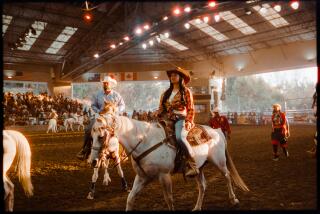Along for the Rickshaw Ride
- Share via
CHASING RICKSHAWS by Tony Wheeler, photographs by Richard I’Anson (Lonely Planet, hardcover, $34.95).
I have few regrets about things I’ve done while traveling, and Lonely Planet’s first-ever coffee-table book unearthed one of them.
This unusual volume opens in Agra, India. There’s a shot of a 65-year-old man who has been pedaling rickshaws for 40 years. The text says he rents his vehicle--a three-wheeler with a bicycle in front and a two-passenger seat in the rear--for 50 cents a day. On a good day he can bring home as much as $3.
Seeing that, I thought of a monsoon-washed morning in Agra 25 years ago, when I climbed into a three-wheeled rickshaw and spent the day being pedaled from the Taj Mahal to Agra Fort and a dozen surrounding sights and shops. The “rider”--as the fellow who does the pedaling is called--was a pleasant man in his 40s, and we laughed and talked as we toured.
I was 19 and had been traveling for four months on what then seemed a hard-earned life savings of $500. Still, it struck me as vaguely shameful for a healthy young dude to be pulled by a life-weathered man twice his age and half his weight. So eventually I talked the rickshaw rider into switching places, and for a while I pedaled him through the streets, both of us whooping with exhilaration and terror.
Dickering over fares with predatory, aggressive rickshaw drivers is an art and a matter of honor in parts of Asia. But when our day ended, my rider merely lowered his eyes and said, “whatever is fair.” So I paid him the going rate--something like 50 cents, I imagine--then gave him what was, by local standards, a generous tip: another 50 cents or so.
He nodded his head with his hands folded at chest level and thanked me. Only after he’d pedaled off did I realize--or admit--that his eyes reflected disappointment. The look that haunts me, though, is the one that never was, the one I’m now certain he had envisioned appearing on his wife and children’s faces as we rode: the proud, joyful smiles greeting him as he walked in with a fistful of rupees--$5 or $10 maybe; a real, life-altering stake in the future--handed to him by the wonderful young American he’d befriended.
The text of “Chasing Rickshaws” explains how they are made and recycled, and how riders ply their trade. The vehicles themselves, as the author notes, are low-tech marvels, often a fusion of folk art and transportation.
But “Chasing Rickshaws” is essentially a picture book, and the images are wonderful: Ten white-shirted schoolchildren pile onto a rickshaw in India; in Hanoi, a different style rickshaw sports a flock of ducks peering from bags and baskets.
The most captivating shots are of the riders. Their faces speak volumes about economic injustice and the toll life takes on the working poor. They also say a lot about life’s simple sources of joy: enterprise, physical exertion, human interaction, surviving another day. And I can’t help but notice that in comparing the passengers’ and pedalers’ faces, the latter invariably reveal more character, more soul.
Quick trips
CANINE COLORADO, Where to Go and What to Do With Your Dog by Cindy Hirschfeld (Fulcrum Publishing, $16.95, paper).
Books on traveling with pets are a niche market these days. This one is full of info on motels, trails, parks, campgrounds, etc., and its advice seems particularly good and sensible. Some books, for instance, scold dog owners who fail to filter their pet’s water when backpacking. This one--perhaps the author has noted that pooches will eagerly drink from toilets--doesn’t get so neurotic.
ADVENTURE GUIDE TO THE ALASKA HIGHWAY by Ed and Lunn Readicker-Henderson with David Trainer and Leslie Hall (Hunter Publishing Inc., $15.95, paper).
The 1,500-mile highway from Dawson City, British Columbia, through the Yukon into Alaska is a wonder. This is a decent guide with good advice--though no substitute for the tackier, more commercial but indispensable Milepost guide that savvy travelers carry.
ARTISTS AND THEIR MUSEUMS ON THE RIVIERA by Barbara F. Freed, with Alan Halpern (Harry N. Abrams Inc., $19.95, paper).
Henri Matisse described the Co^te d’Azur’s light as “soft and tender, in spite of its brilliance.” Drawn by that light and other intangibles, dozens of this century’s most celebrated artists have flocked to the French Riviera. Here’s a guide, with photos, to 28 museums, most of them intimate, displaying the work of Pablo Picasso, Marc Chagall, Fernand Leger, Jean Cocteau and others.
LAND OF THE CANYONS: A Photographic Guide to the American West by Laurent Martres (PhotoTripUSA, $14.95).
A fine little spiral-bound volume, with black-and-white photos and lots of concise information for exploring and photographing Zion, Bryce Canyon, Arches and Capitol Reef national parks and other slick-rock and slot-canyon wonders of the Southwest.
Books to Go appears the second and fourth week of every month.
More to Read
Sign up for The Wild
We’ll help you find the best places to hike, bike and run, as well as the perfect silent spots for meditation and yoga.
You may occasionally receive promotional content from the Los Angeles Times.






